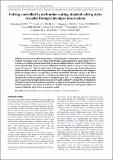Files in this item
Calving controlled by melt-under-cutting : detailed calving styles revealed through time-lapse observations
Item metadata
| dc.contributor.author | How, Penelope | |
| dc.contributor.author | Schild, Kristin M. | |
| dc.contributor.author | Benn, Douglas I. | |
| dc.contributor.author | Noormets, Riko | |
| dc.contributor.author | Kirchner, Nina | |
| dc.contributor.author | Luckman, Adrian | |
| dc.contributor.author | Vallot, Dorothée | |
| dc.contributor.author | Hulton, Nicholas R.J. | |
| dc.contributor.author | Borstad, Chris | |
| dc.date.accessioned | 2019-03-01T15:30:22Z | |
| dc.date.available | 2019-03-01T15:30:22Z | |
| dc.date.issued | 2019-01-30 | |
| dc.identifier | 257989634 | |
| dc.identifier | aed7fd3e-cc57-40a2-8deb-4788ec464af0 | |
| dc.identifier | 85060785125 | |
| dc.identifier | 000469785700004 | |
| dc.identifier.citation | How , P , Schild , K M , Benn , D I , Noormets , R , Kirchner , N , Luckman , A , Vallot , D , Hulton , N R J & Borstad , C 2019 , ' Calving controlled by melt-under-cutting : detailed calving styles revealed through time-lapse observations ' , Annals of Glaciology , vol. First View . https://doi.org/10.1017/aog.2018.28 | en |
| dc.identifier.issn | 0260-3055 | |
| dc.identifier.other | ORCID: /0000-0002-3604-0886/work/64697383 | |
| dc.identifier.uri | https://hdl.handle.net/10023/17195 | |
| dc.description | This work is affiliated with the CRIOS project (Calving Rates and Impact On Sea Level), which was supported by the Conoco Phillips-Lundin Northern Area Program. PH is funded by a NERC PhD studentship (reference number 1396698). | en |
| dc.description.abstract | We present a highly detailed study of calving dynamics at Tunabreen, a tidewater glacier in Svalbard. A time-lapse camera was trained on the terminus and programmed to capture images every 3 seconds over a 28-hour period in August 2015, producing a highly detailed record of 34 117 images from which 358 individual calving events were distinguished. Calving activity is characterised by frequent events (12.8 events h-1) that are small relative to the spectrum of calving events observed, demonstrating the prevalence of small-scale calving mechanisms. Five calving styles were observed, with a high proportion of calving events (82%) originating at, or above, the waterline. The tidal cycle plays a key role in the timing of calving events, with 68% occurring on the falling limb of the tide. Calving activity is concentrated where meltwater plumes surface at the glacier front, and a ∼ 5 m undercut at the base of the glacier suggests that meltwater plumes encourage melt-under-cutting. We conclude that frontal ablation at Tunabreen may be paced by submarine melt rates, as suggested from similar observations at glaciers in Svalbard and Alaska. Using submarine melt rate to calculate frontal ablation would greatly simplify estimations of tidewater glacier losses in prognostic models. | |
| dc.format.extent | 12 | |
| dc.format.extent | 768177 | |
| dc.language.iso | eng | |
| dc.relation.ispartof | Annals of Glaciology | en |
| dc.subject | Arctic glaciology | en |
| dc.subject | Glacier calving | en |
| dc.subject | Ice dynamics | en |
| dc.subject | Ice/ocean interactions | en |
| dc.subject | GE Environmental Sciences | en |
| dc.subject | Earth-Surface Processes | en |
| dc.subject | DAS | en |
| dc.subject | SDG 14 - Life Below Water | en |
| dc.subject.lcc | GE | en |
| dc.title | Calving controlled by melt-under-cutting : detailed calving styles revealed through time-lapse observations | en |
| dc.type | Journal article | en |
| dc.contributor.institution | University of St Andrews. School of Geography & Sustainable Development | en |
| dc.contributor.institution | University of St Andrews. Bell-Edwards Geographic Data Institute | en |
| dc.identifier.doi | 10.1017/aog.2018.28 | |
| dc.description.status | Peer reviewed | en |
This item appears in the following Collection(s)
Items in the St Andrews Research Repository are protected by copyright, with all rights reserved, unless otherwise indicated.

